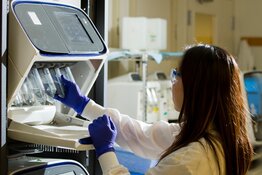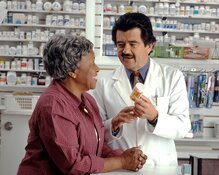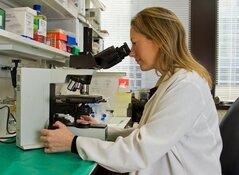The Life Sciences Report: You are a boutique firm. What kind of flexibility does that give you, and how does that translate to your clients' benefit?
Steve Brozak: We are an independent full-service broker-dealer, and we have a distribution system of independent brokers who are not wed to any product or product mix. Our size gives us the flexibility to take advantage of any opportunities that come up. We can be just as competitive as the bulge-bracket firms in a lot of categories, but at the same time we are able to screen down to a small number of candidates to write research on. We can filter the tremendous universe of healthcare companies, ideas and programs down to a manageable number.
TLSR: Are small caps your specialty?
SB: Yes, by definition. But small-cap companies very often have as their partners the largest companies on the face of the planet, those being the large pharmaceutical, biotech or medical device companies. We have to have a good grasp on what the entire industry is doing, what deals and strategic arrangements may be more beneficial than others. We listen to all conference calls of the big pharmaceutical and biopharmaceutical companies, we listen very carefully to the guidance management gives and we review the numbers, public announcements and Securities and Exchange Commission filings.
TLSR: Back in mid-February you moderated the diagnostic workshop at the 2012 BIO CEO & Investor Conference in New York City. What was your topic?
SB: We have now progressed into the new era of personalized medicine. When people think of diagnostics, they think CAT scans and antibody-based tests and other such modalities. The reality is that some of the most advanced diagnostic technologies are related to disease indication and drug development. For example, we cover Celldex Therapeutics (CLDX:NASDAQ), which has a product, rindopepimut (CDX-110), in phase 3 trials for glioblastoma multiforme (GBM). The product is for a subset of patients that expresses a certain active receptor, EGFRvIII, which represents about 13,000 patients in the U.S. and European Union alone. Its expression is associated with reduced overall survival. EGFRvIII is not expressed in a healthy brain, which makes it a good target. If you have that marker, the product will work much, much better than it will in a general population of GBM patients. It is about specific targeted therapy and the factors that will optimize the drug for a patient. That is what we are looking at, and that was the premise of our workshop, "Drugs Need Friends Too: Companion Diagnostics and Drug Development," at the conference.
TLSR: The workshop was focused on personalized medicine?
SB: Yes, it was about the evolving role of companion diagnostics being a drug's best friend and determining a rational, targeted approach to treatment protocol in dealing with the most devastating diseases. Essentially, companion diagnostics become a drug's best friend by determining the patients for whom the therapy will be most effective.
TLSR: Steve, will initial public offerings (IPOs) return as a normal, or at least a more frequent, exit strategy for biotechs?
SB: No.
TLSR: Do you think the business model for the startup biotech is just not suited to that?
SB: We have seen a restructuring of the capital markets, and the outcomes so far have been unsatisfactory. People think IPOs in biotech are a mainstay in the markets, but in reality they have not been as frequent or as large as they were in the 1990s and early 2000s. You had the granddaddy of IPOs with Genentech (now a unit of Roche Holding AG [RHHBY:OTCPK]). I think it is very difficult for the structure of an IPO to come out today because there are no common denominators like earnings before interest, taxes, depreciation and amortization (EBITDA) for these companies. So what do you do? How do you quantify something that is five or 10 years into the future? You also have regulatory and governmental questions that you just can't answer in a five-minute discussion. One of the great difficulties is that portfolio managers manage so much money that when really good values appear in IPOs, they may not be able to invest because they can't get enough shares to make it worthwhile in a large fund. To say the least, it is a challenging environment.
TLSR: What if, for example, your venture capital (VC) friend comes to you and says, Steve, we want to do an IPO in such-and-such company that you are familiar with. If you like the company, do you tell the VC that you won't buy the IPO, but you may buy later, after shares have been floated? Do you have those kinds of conversations with venture people?
SB: Yes, we do have conversations with venture capitalists asking us how they might get out of a position. We've had many a conversation in which we have been asked what we think the price range is. They draw their breath back in when they hear our price range. You have to price it so that something is left on the table for investors. The VCs may be looking at the proverbial down-round, but you can ultimately make a lot more money by having everyone make money, rather than on a short-term blip. A lot of times, people come to us for IPO participation and we say no. We'd rather sit back, wait, watch and be able to write research about it, since IPO rules prohibit brokers from writing on something right away if they are IPO participants. Sometimes we just sit back and become the first company to write about the newly public company.
TLSR: How do you choose your research coverage? What do you look for first in a life sciences company that you are thinking of covering?
SB: Management. Management has to be there. There are many great ideas out there, but you have to make sure that management is able to tell the story. That's the reality.
TLSR: Do you want to see someone who's done it before?
SB: It helps, but not always. It's more along the lines of whether they get it and understand, and whether they have a hunger. The hunger part is really important. Kids play house; we see too many executives who want to play company.
TLSR: Does it bother you when a scientific founder wants to run a company?
SB: Not always. You have founder's syndrome, of course. The reality is that it depends. Not all founders are created equal.
TLSR: You seem to be weighted toward stem cell technologies. Why is that?
SB: We believe these technologies offer the broadest possible potential for the future healthcare demographic problems we are seeing.
TLSR: Have we touched the tip of the iceberg in stem cell technologies yet?
SB: No.
TLSR: Where and when will we see the breakthroughs?
SB: I don't know where the breakthrough will take place. That's why we talk to all the companies in the space. When it does take place, it will truly be different, and it will be even more pivotal than the development of Salvarsan (arsphenamine, often thought of as the first modern drug) or the introduction of antibiotics. That's how meaningfully different it will be. You're dealing with the basic building blocks of biology, so the science is exceedingly powerful. With something this powerful, there is probably a negative logarithmic factor that tells how long and winding the road to the proverbial healthcare paradigm shift is going to be. If I were to envisage what to look for it would probably be something related to regulating the body's immune system and maximizing its ability to combat infection or disability.
TLSR: The applications are so potentially broad that you almost don't know where to start. To use a cliché, you don't know what you don't know.
SB: Every single major discovery I've seen has been in the form of a serendipitous relationship. Usually the researchers were experts in one field, and they found something related to what they were researching in another field. Their broad-based knowledge and technology were used for something else.
TLSR: Can we talk about your ideas? What are you telling investors about?
SB: We are telling them to be countercyclical. Our performance is typically accentuated most when the markets are in trouble. We can go out there and pick out those companies where everything is solid. It is a function of taking advantage of the right buying opportunity. I'll give you an example. We sat down with Navidea Biopharmaceuticals Inc. (NAVB:NYSE) (formerly Neoprobe Corp.) and got an investor to fund the company fully through a phase 2/phase 3 study. Navidea currently has a Prescription Drug User Fee Act (PDUFA) date of Sept. 10, 2012. The company's market cap was $15 million (M), and we had to figure out a way for an investor to inject $16M into it. It was such an important science, and we had the data there. We just had to figure it out. It took us 18 months to actually craft the transaction, and it worked out for advancement of the company, its science and the investor.
TLSR: Navidea has a quite nice market cap compared to $15M that it had.
SB: We had to stage the entry of the funding so that it would not overwhelm the company and change the capitalization structure.
TLSR: What is the technology there?
SB: It is simple, but it's elegant. Technetium Tc 99m is a short-lived radioactive isotope used in a suspension system called Lymphoseek (tilmanocept). It is being developed as a diagnostic tracing agent to be used in gamma detection devices in a surgical procedure known as intraoperative lymphatic mapping. You want to be able to track the lymphatic system to make sure you have picked up a cancer if it has metastasized out of the primary site. The sulfur colloid that has been used off-label for the same purpose has two problems: First, because of its pH, it is very painful; and second, the molecular weight is so large you can only use it in certain types of cancers. Also, there is no standardization. Lymphoseek has a much smaller molecular weight, and it works for every solid tumor. This next-generation product already has a distribution partner in Cardinal Health Inc. (CAH:NYSE), and we should see quick distribution take place. The idea is to expand the universe to the entire world and obtain better outcomes for solid tumor treatment throughout the body.
TLSR: The purpose is to detect disseminated disease?
SB: Right.
TLSR: What's your target price on Navidea?
SB: It's at $9.00.
TLSR: That's almost 200% upside potential.
SB: I think that's a fair target price. We'll see what happens with the PDUFA date.
TLSR: What else are you talking to investors about, Steve?
SB: We've been talking about the stem cell universe. I don't believe we have a full appreciation of how quickly the potential indications and positive outcomes can come to market. We also talk to investors about "dual use," because one of the significant areas we're looking at is government involvement. I am tired of politicians saying that government isn't the answer. On the vaccine side, just think of where we would be if the government hadn't stepped in.
TLSR: Can you elaborate?
SB: A generation ago we had 20 vaccine makers. Then we were down to two—and then one of them failed. If it hadn't been for the government stepping in and spending billions of dollars, I don't know where we would be now. It's just not an efficient system, and any politician who says let the free markets take care of it doesn't understand how the free markets work. The free markets require incentives to make products, and over the last several decades we've seen the incentives to produce certain types of products diminish, whether it be regulatory or profit motive. Regardless, free markets require these incentives to maintain and advance certain technologies.
TLSR: What specific stem cell ideas are you talking to investors about currently?
SB: I'm talking about which company will be first through the gate. On the adult stem cell side, we like a number of different companies, such as Cytori Therapeutics (CYTX:NASDAQ), Athersys Inc. (ATHX:NASDAQ), Aastrom Biosciences Inc. (ASTM:NASDAQ) and BioTime Inc. (BTX:NYSE.A). Actually, BioTime transcends both adult and embryonic stem cells. We are looking at companies that have different approaches, and we think they make sense. A little company, NeoStem Inc. (NBS:NYSA.A), has some very interesting and novel technology. We listen to every story. We listen because no one has a monopoly on new science or on strategic advantage.
TLSR: You like all of those companies, and you are following all of them?
SB: We follow almost every stem cell company. I'm sure there are some companies working out of some incubator somewhere that we don't follow, but technology-wise, we're pretty familiar with everything that is published.
TLSR: What do you think about embryonic stem cell company Geron Corp. (GERN:NASDAQ) getting out of its stem cell program and concentrating on its cancer program? What does that tell you?
SB: I think it will be a terrific opportunity for whoever acquires the technology.
TLSR: What about StemCells Inc. (STEM:NASDAQ) using adult cells derived from embryonic tissue?
SB: We have a Sell rating on StemCells. What it's doing is a very expensive proposition. In our opinion, funding is always problematic and you can never predict what you will need to spend, only try to ensure that you have access to the needed capital. That's one of the problems we have with StemCells.
TLSR: What else are you currently recommending?
SB: There's a small company called Vision Sciences Inc. (VSCI:NASDAQ), with a market cap of about $76M. Candidly, that market cap just boggles my mind. The company has a disposable sheathing system that goes over any kind of scope that is inserted into the body. The optics are fantastic. For a typical procedure, the equipment being put into your body is cleaned but not sterilized, and you can have problems with cross-contamination. We've seen it happen. This sheathing system should be the industry standard for every single scoping system. Any time a lens enters the body, there should be a disposable sheath attached to it so there is no possibility for contamination. I'm really bothered that this issue hasn't been addressed, because contamination and resulting infection is a recurring problem.
TLSR: It is like a gloved hand.
SB: Exactly. It's the same thing. How would you feel if you went in for a surgical procedure and the surgeon wasn't gloved?
TLSR: What are you recommending on the larger-cap side?
SB: Cyberonics Inc. (CYBX:NASDAQ) has an implantable vagus nerve (cranial nerve X) stimulation (VNS) system that has shown remarkable results for epilepsy patients, and now it is seeing expanded use for refractory depression patients. We started with a Sell recommendation, and then went to a Sell Short after we listened to a presentation that we were not that enthusiastic about. It did not meet our standards. Based on the current VNS trend and potential, we now have it rated Strong Buy.
TLSR: You have written some research on Cempra Inc. (CEMP:NASDAQ), the antibiotic company. You have it rated Speculative Buy with an $8.50 target price.
SB: Cempra was founded in 2006, and had its IPO not too long ago. It is addressing the growing threat of antibiotic-resistant infections and has products in development completing phase 2 studies. One is broad spectrum CEM-101 (solithromycin) for community-acquired respiratory tract infections. The other, TAKSTA (sodium fusidate), is a gram-positive antibiotic with a long history of safety and efficacy outside the U.S. Cempra has exclusive rights to it in the U.S.
TLSR: Are there any other companies you wanted to mention?
SB: In mid-March Omeros Corporation (OMER:NASDAQ) announced stellar phase 3 results for its second lead product, OMS302, which can reduce the inflammatory cascade and provide for better outcomes in ophthalmological procedures, such as lens replacement and cataract surgery. Omeros is using generic products in a platform technology, allowing for multiple drug combinations. OMS302 is added to the standard irrigation solution delivered into the anterior chamber of the eye to prevent constriction of the pupil and to reduce inflammation and post surgical pain.
TLSR: I've enjoyed speaking with you. I hope we can do this again in the future.
SB: I'm happy to chat. Thank you.
WBB Securities Managing Partner and President Stephen G. Brozak has been in the securities industry for 25 years. He has held positions in sales, management, investment banking and research analysis. He has been intimately involved in providing research on a number of companies for the last 13 years. Brozak has a bachelor's degree and a master's degree in business administration from Columbia University, and is a retired lieutenant colonel in the United States Marine Corps.
Want to read more exclusive Life Sciences Report interviews like this? Sign up for our free e-newsletter, and you'll learn when new articles have been published. To see a list of recent interviews with industry analysts and commentators, visit our Exclusive Interviews page.
DISCLOSURE:
1) George S. Mack of The Life Sciences Report conducted this interview. He personally and/or his family own shares of the following companies mentioned in this interview: None.
2) The following companies mentioned in the interview are sponsors of The Life Sciences Report: None. Streetwise Reports does not accept stock in exchange for services. Interviews are edited for clarity.
3) Stephen Brozak: I personally and/or my family own shares of the following companies mentioned in this interview: Navidea Biopharmaceuticals Inc. I personally and/or my family am paid by the following companies mentioned in this interview: None. I was not paid by Streetwise Reports for participating in this story.




































